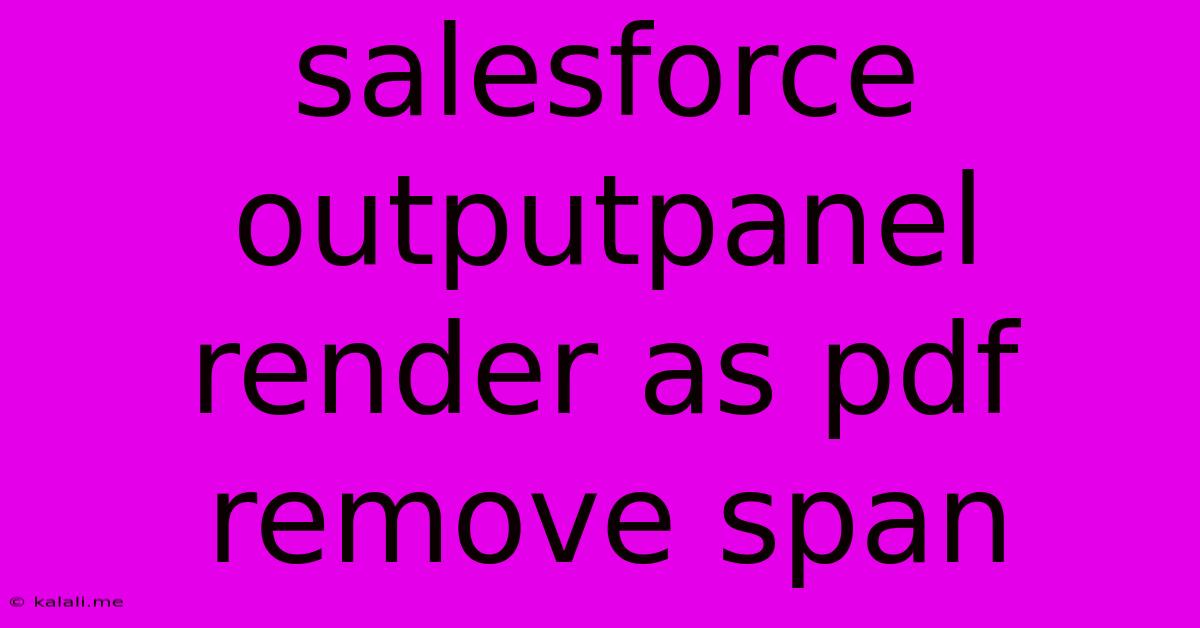Salesforce Outputpanel Render As Pdf Remove Span
Kalali
May 23, 2025 · 3 min read

Table of Contents
Salesforce OutputPanel Render as PDF: Removing Unwanted Spans
Generating PDFs from Salesforce Visualforce pages using the OutputPanel component is a common task, but sometimes you encounter unexpected formatting issues. One frequent problem is the appearance of unwanted <span> tags within your PDF output, disrupting the intended layout and readability. This article will guide you through troubleshooting and resolving this issue, focusing on effective strategies for clean PDF generation. This is crucial for maintaining professional-looking documents and ensuring data integrity.
This article will cover: identifying the source of unwanted spans, techniques for removing them, and best practices to prevent this issue in the future. We'll explore both Visualforce and Apex solutions, giving you a comprehensive approach to tackling this common Salesforce PDF generation challenge.
Identifying the Source of Unwanted Spans
Before jumping into solutions, understanding why these spans appear is essential. They often originate from:
- Visualforce Components: Certain Visualforce components, especially those relying on JavaScript frameworks or dynamic styling, may inadvertently inject
<span>tags during rendering. - CSS Styling: Overly aggressive or poorly written CSS rules might unintentionally introduce spans for layout purposes.
- Third-Party Packages: Custom Visualforce components or third-party libraries could be contributing to the problem.
- HTML Rendering Differences: The way Salesforce renders HTML for display might differ from how it renders for PDF generation.
Techniques for Removing Unwanted Spans
There are several methods to tackle unwanted spans in your Salesforce PDF output:
1. CSS Styling Adjustments:
- Specificity: Carefully review your CSS and ensure styles are highly specific to avoid unintentional application to your
OutputPanel. Use more specific selectors to override the styles causing span insertion. display: none;: If you identify the specific CSS class or ID causing the span issue, you can usedisplay: none;within your CSS to hide them only during PDF generation. This requires conditional CSS application (explained later).- Removing Inline Styles: Try to avoid inline styles as much as possible. Keep styling in external CSS files for better maintainability and easier control.
2. Visualforce Markup Adjustments:
- Direct Removal (Not Recommended): Directly removing
<span>tags from your Visualforce markup is generally discouraged because it can break functionality or cause unexpected behavior. Only do this as a last resort if you understand the implications. - Alternative Rendering: Consider restructuring your Visualforce markup to avoid the need for spans in the first place. This might involve using different components or rearranging elements.
3. Conditional CSS using Apex:
This is a robust and preferred method. You can dynamically modify your CSS based on the rendering context (screen vs. PDF).
- Create a custom Apex controller or extension that detects whether the page is being rendered for PDF generation (e.g., by checking a controller parameter).
- Based on this detection, dynamically add or remove CSS classes or styles within your Visualforce page using Apex. For example, you could add a class like
pdf-renderto your stylesheet when generating PDF. - Use this class in your CSS to apply styles specific to PDF generation (e.g., overwriting styles that introduce spans).
4. Using a PDF Generation Library (Advanced):
For complex scenarios, consider using a dedicated PDF generation library within your Apex code. These libraries offer more control over the final PDF output and might avoid the problems caused by Visualforce’s HTML-to-PDF conversion.
Best Practices for Preventing Spans
- Modular CSS: Utilize modular CSS and avoid writing overly general styles.
- Thorough Testing: Always test your PDF generation thoroughly. Include scenarios that simulate different data conditions to catch potential issues early.
- Version Control: Use version control (like Git) to track your Visualforce and CSS changes, making it easier to revert to previous working versions if problems arise.
By implementing these strategies and adopting best practices, you can effectively eliminate unwanted <span> tags from your Salesforce OutputPanel PDF renders, resulting in cleaner, more professional-looking documents. Remember to always prioritize a well-structured and maintainable codebase to minimize future problems.
Latest Posts
Latest Posts
-
Natlib Limit On Number Of Authors
May 23, 2025
-
Variable State Space In Reinforcement Learning
May 23, 2025
-
Do Presbyterians Believe In Replacement Theology
May 23, 2025
-
Is Attorneyt Generals Office Without The State Capitalized
May 23, 2025
-
Machine Learning Fuse Two Dataset Without Iid
May 23, 2025
Related Post
Thank you for visiting our website which covers about Salesforce Outputpanel Render As Pdf Remove Span . We hope the information provided has been useful to you. Feel free to contact us if you have any questions or need further assistance. See you next time and don't miss to bookmark.